Here is the Volume 1 of Hockey from When you watch something, visit us first! Mr. Manabu YAMASHITA, Coach of Japanese men’s national Hockey team “Samurai Japan”, told us about the basic knowledge of Hockey this time. This is the complete version of Part 1 & 2 on our YouTube channel.
When we watch a Hockey matches, it stops frequently. It looks similar to Soccer, but what is the difference?
This time, with the cooperation of Japan Hockey Association, Mr. Manabu YAMASHITA, Coach of Japanese men’s national Hockey team “Samurai Japan”, told us the basic knowledge of Hockey.
We would like to thank Japan Hockey Association, especially Head Coach of Samurai Japan, Mr. Akira TAKAHASHI, for their great help in making this video. We would like to express our sincere gratitude.
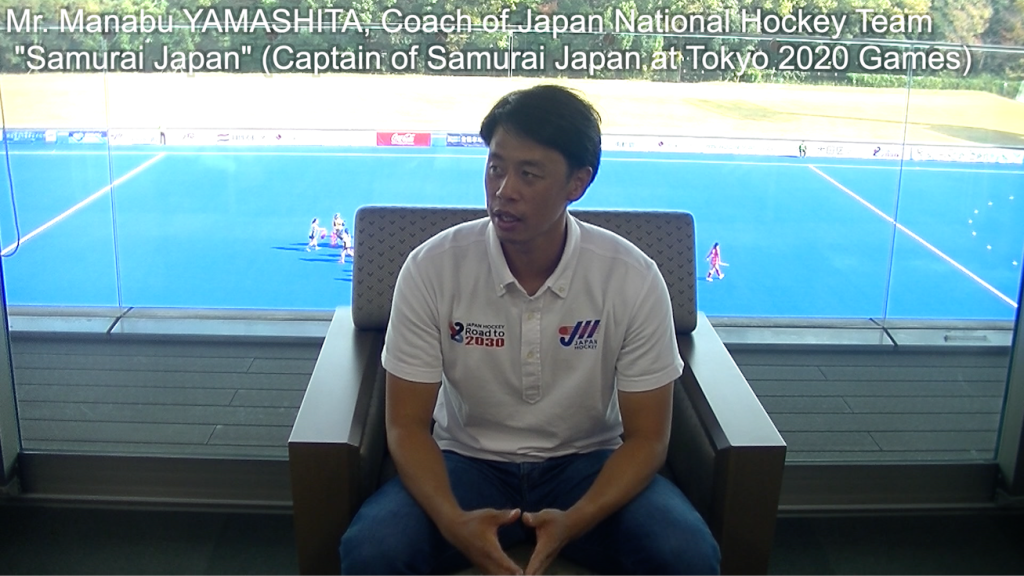
Part 1: Basic Knowledge of Hockey (From the differences with soccer)
Similarities with soccer
Let me explain Hockey.
Hockey and Soccer have the same number of players (11 vs. 11), and the same positions in soccer, i.e. Forward (FW), Midfielder (MF), Defense (DF), and Goalkeeper (GK), and some teams adopt the same formation as in soccer. It is the same as in Soccer, DF player, such as Side back, sometimes overlap and join Offense, or FW players sometimes come back to defend, and they connect short or long passes to head toward the opponent’s goal.
Differences from Soccer ① Offside / Body Contact
As there is no offside In Hockey, so the pitch can be used vertically wide although the sides are limited, it is a sport where Offense and Defense switch quite quickly.
In Soccer, when controlling the ball, players put their own body between the opponent and the ball to prevent the ball from being taken away, but in Hockey, body contact is basically prohibited, so I think the difference between Hockey and Soccer is how the players keep the ball and go toward the opponent’s goal without using their bodies.
Differences from Soccer ② Circle
This is what a pitch of Hockey looks like. And this semicircular “Circle” in front of the goal is the important point.
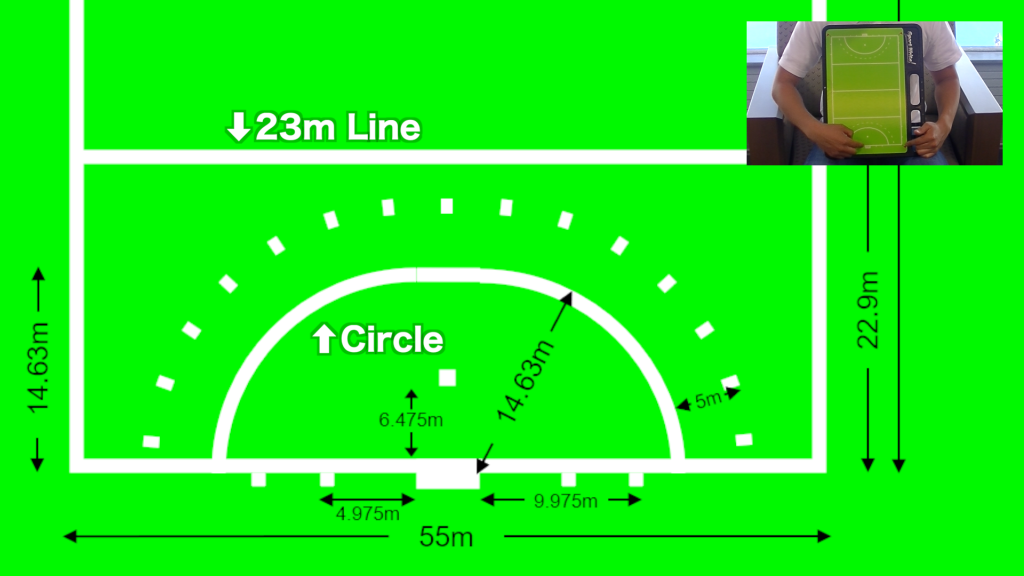
And this semicircular “Circle” in front of the goal is the important point. In Soccer, OF player can score a goal with a shoot from anywhere on the pitch, but in Hockey, OF player must shoot from inside this Circle to score a goal. If OF player hits the ball from outside the Circle, it is scored if any his teammate touches it inside the Circle and puts it in the goal.
If DF player fouls in the Circle, it leads a “Penalty Corner”. In particular, when DF player takes the ball from the opponent, such player basically “clears” it, but if this player clears it toward the back line, this is also a Penalty Corner, and the probability of score is also high in Hockey. DF is at a considerable disadvantage.
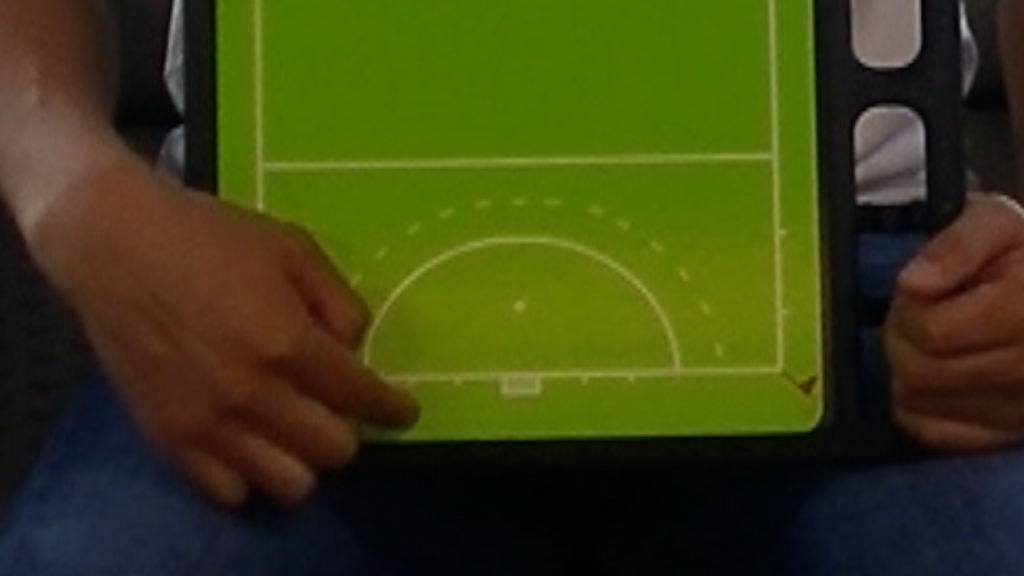
The Circle is important in Hockey because even if OF players are playing well in a large central area around here, they cannot score unless they have the ball inside the Circle.
Differences from Soccer ③ Stick
The stick has a flat side and a round side, but players should only handle the ball on this flat side.
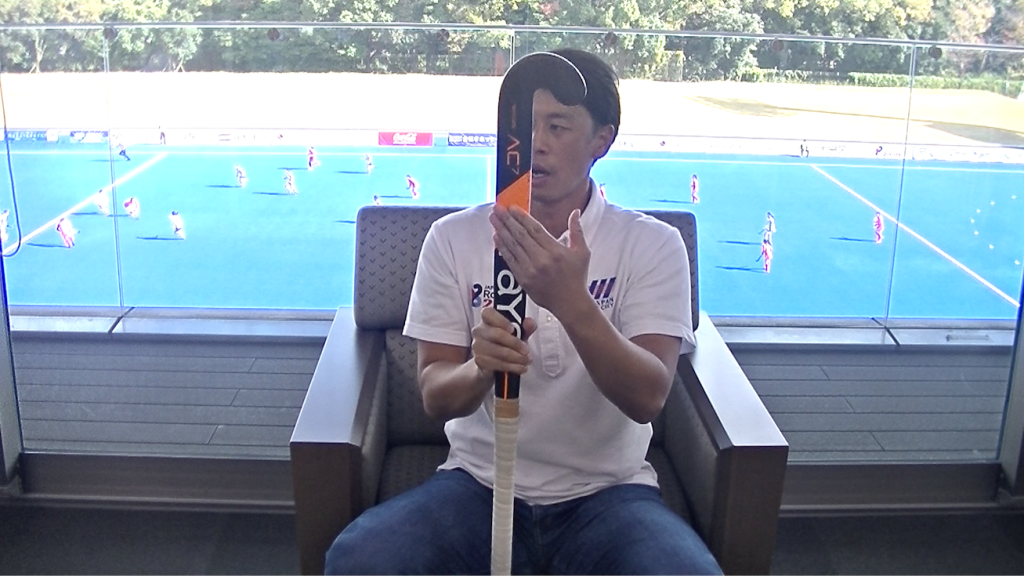
If players handle the ball on the round side, it is a foul called “Back Stick”.
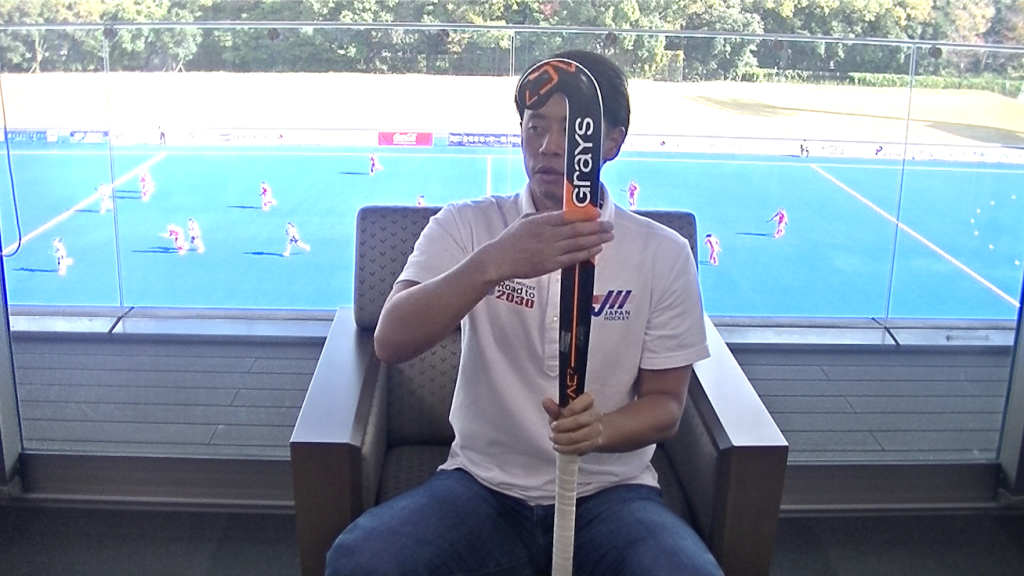
Players can only handle the ball on this flat side, so when the ball is on their left, they must flip the Stick and always handle it on this side.
Even though some players are left-handed, they all hold their sticks in the same way.
Holding the Stick on the right side is considered strong, and the basic tactic is to attack from the opponent’s weak point, not from the strong point, so if the DF player is standing like me, OF players will attack DF player’s left side, so it is often to attack from their own right side in Hockey.
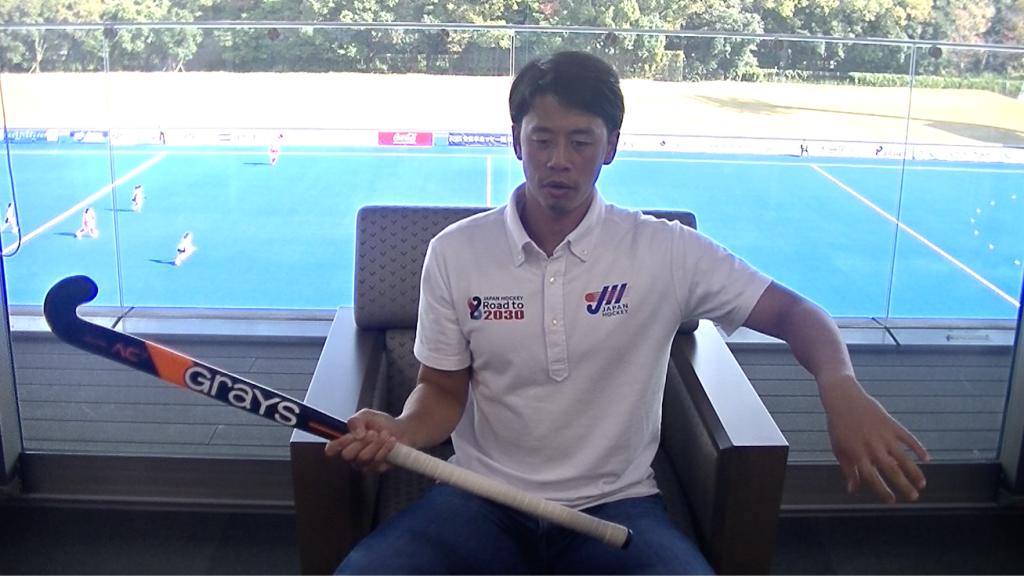
In Soccer, players handle the ball with their own body, so it may be easy to control the force to some extent, but in Hockey, however, ball control is very important, whether they use their Stick to stop a strong ball with some force or with fending off the ball, and the difficulty increases because they use Sticks.
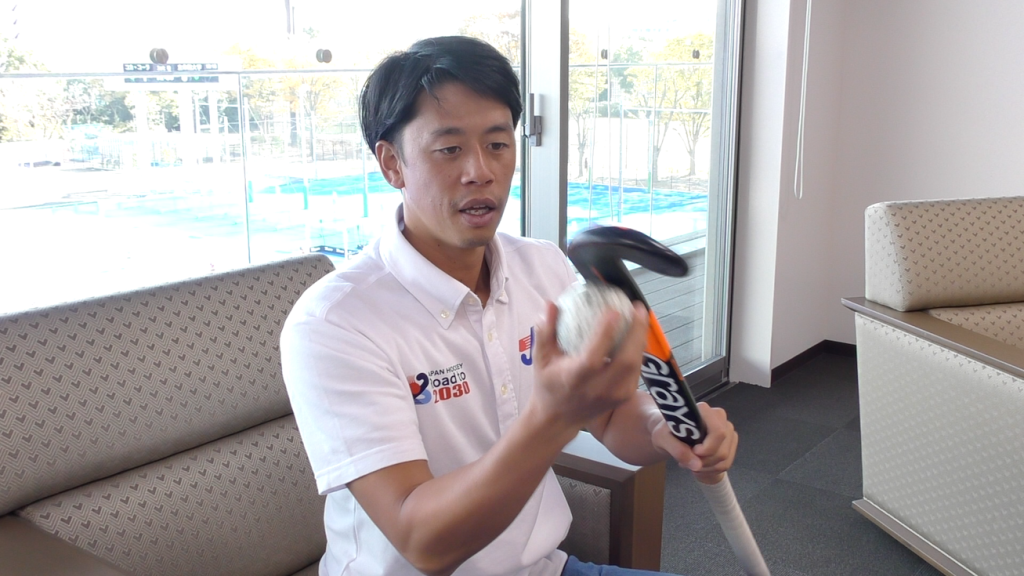
Hockey balls are quite hard. It is about the size of a baseball and about as hard as a golf ball.
The ball is this size, and the face of the Stick is only this wide, so that the ball protrudes a little from the face, and the ball is larger.
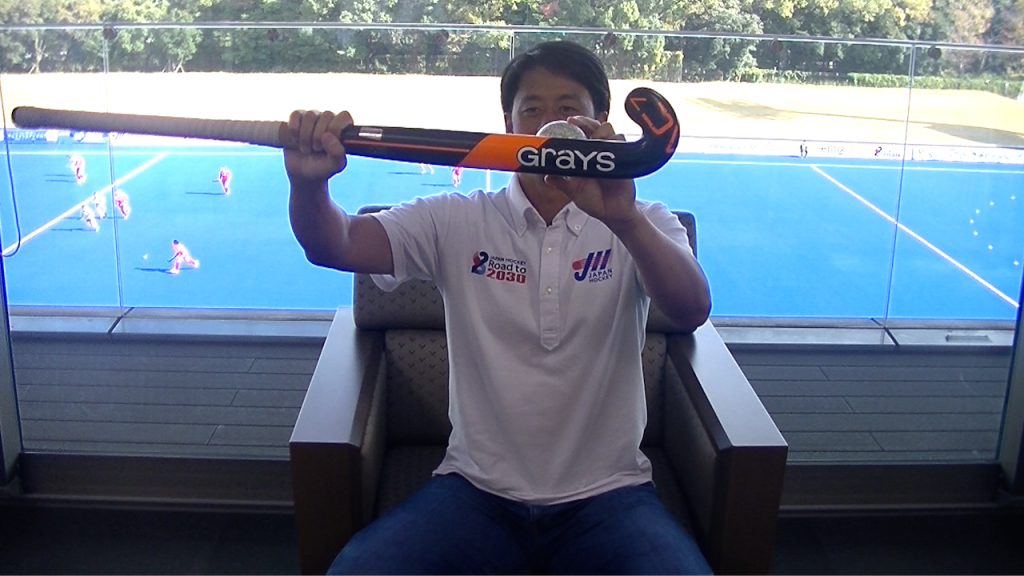
So it is quite difficult in Hockey to control a strong ball well with a Stick.
The ball does not always roll and sometimes it bounces, and it is difficult to apply the Stick as which direction to the bouncing ball to control it, and if some very skilled players can stop the ball firmly where you want. When you are watching Hockey, a player who are good at controlling the ball is great.
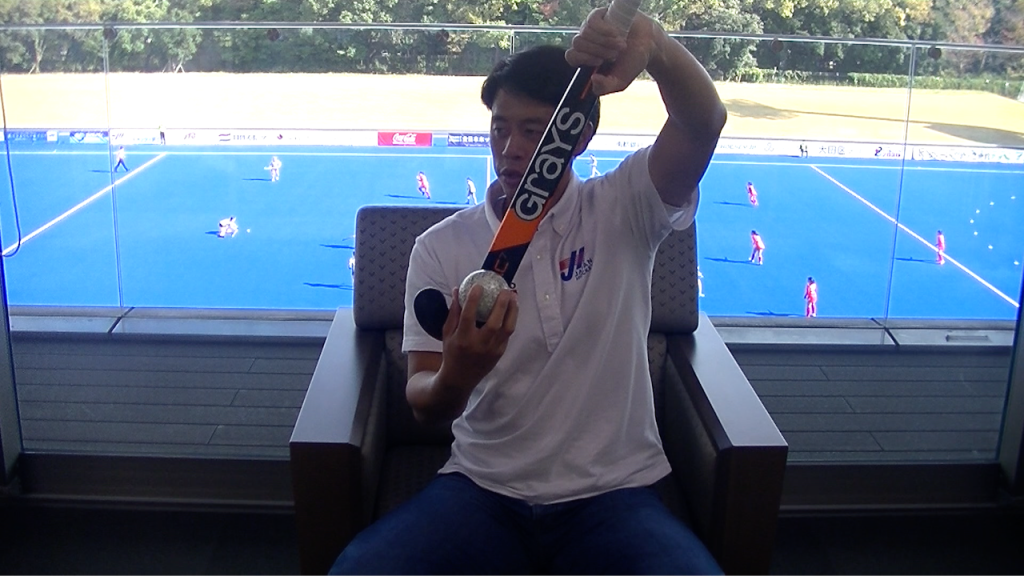

Hockey is a sport in which there are many mistakes, but the top teams make few such mistakes, and I feel that this is the difference between them and us.
Differences from Soccer ④ Safety Policy
If the ball hits a players foot, it is a foul, and if the ball rises above his knees, it is considered dangerous as a “Dangerous Ball”, and safety is protected by such rules in Hockey. If the ball rises above the knees, even slightly, Umpire will always blow the whistle, and if a player hits the opponent’s Stick by his own Stick, it is also a foul.
Since Hockey originated as a “Gentleman’s sport,” acts such as “hitting the Stick” and such “dirty fouls” are basically not tolerated. Since the ball is fast, the Umpire will be very strict about such dangerous balls.
Differences from Soccer ⑤ Substitution
If players run out of energy at a crucial point, they will not be able to reach the goal at the end, and I think that many teams are changing players by 3 to 4 minutes tactically. Now 4 quarters of 15 minutes are played, but it used to be 2 halves of 35 minutes, although in Hockey substitutions can be made unlimitedly, we didn’t make so many substitutions. However, recently, with the 4 quarters of 15 minutes, the tempo of the match has quickened, so the 3 FW players are repeatedly replaced by a total of 3 to 4 minutes. MF also plays both OF and DF, so they play from 4 to 3 minutes for each playing time.
Part 2: When Hockey match stops
Match Stopping Foul ① Obstruction
In Hockey, players have to control the ball only with the Stick, so body contact, as in Soccer, is immediately a foul. Also, intentionally hiding the ball like this way so that to prevent it from being taken away is also a foul, which called “Obstruction”.
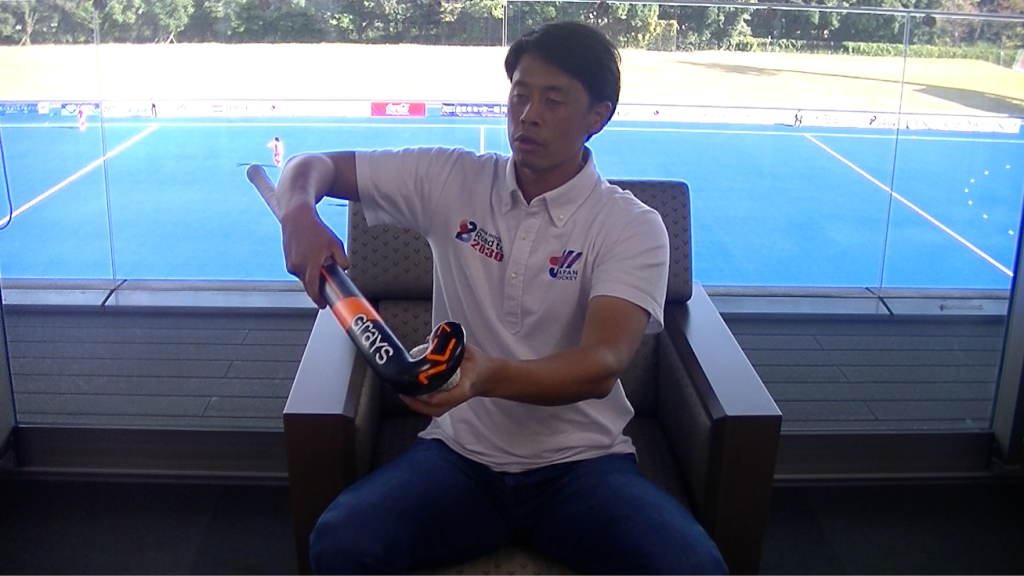
In Hockey, it is basically encouraged to carry the ball fairly, and to hide the ball intentionally is considered a foul, and such fouls are relatively common.
Match Stopping Foul ② Interfere
Foul to hit the opponent’s Stick touching the ball when trying to take the ball away is often seen, and it is quite common for Hockey match to be stopped by such foul.
Match Stopping Foul ③ Dangerous Ball
“Dangerous ball”. It is quite difficult to control the ball when hitting it, and if the ball rises above the knees, it is judged as a Dangerous ball and the match is often stopped.
Match Stopping Foul ④ Body (Kick)
It is a foul if the ball hits the thigh or upper body, so when surrounded by opponents, a player may intentionally put the ball on the opponent’s shin or leg and can restart from there immediately.
Since opponents must be 5 meters away when restarting, taking this foul when the opponents are close and restarting can break the situation since DF player nearby cannot play the ball. Some teams adopt such tactics.
Match Stopping Foul ⑤ Back Stick
difficult to shoot by “Reverse hit” because players have to hit the ball here on the Stick. If there are players using a Reverse hit, they often hit the ball in this way, and “Back Stick” fouls are often occur, but basically they are not seen very much.

In Hockey, I think the foul of “Interfere,” hitting the opponent’s Stick, is one of the main match stopping factors. Then, where not close to the Circle, there are many “Body (Kick)” fouls that the ball hits the foot, or hitting the opponent’s Stick fouls (Interfere). Then there are often “Dangerous ball (play)” fouls when the ball is hit and it rises on a set play.
How to restart ① Free Hit (When the ball comes off the back line)
When OF takes the ball out of the attacking side’s back line, equivalent to a “Goal Kick” in Soccer, a field DF player (non-GK player) restarts the match by Free Hit, also called “Behind,” from somewhere at the top of the Circle.

If the ball touched by DF player and goes outside the back line, the restart will be on the 23m Line, which is the extension of where the ball went out.

When OF restarts from the 23m Line, they cannot send the ball directly into the Circle, therefore, OF must move the ball at least 5 meters before it is sent into the Circle.
How to restart ② Free Hit (when Foul occurs) / Penalty Corner (within the Circle)
When a foul occurs, the match is restarted with a “Free Hit” from that spot. In the past, the player had to pass to someone from such spot, but now, also called “Self Pass,” the player who took the foul can dribble from there to restart himself, making the Hockey match more speedy. In Hockey, the match frequently stops whenever there is a foul, but if the ball is nearby, a player can immediately restart him/herself, which makes Hockey more interesting.
The difference between outside and inside the 23m Line is quite important. If there is a foul here inside the 23m Line, OF cannot put the ball directly into the Circle if Free Hit is done from here. OF must always dribble or pass to someone else to move the ball 5m, before sending it into the Circle. There is roughly 5m between this dotted line and the Circle. If there is a foul between these lines, the ball cannot be put directly into the Circle, so it must go to the right, left, or down before it is put in.

If there is a foul outside the 23m Line, the ball can be hit directly into the Circle from here. The tactic changes a bit between inside and outside the 23m Line.
If there is a foul just outside the 23m Line, OF often hit directly into the Circle, and when a foul inside the 23m Line, OF often use the tactic of dribbling to restart and then immediately putting it in or passing the ball for several times and then sending inside the Circle.
If there is a foul committed by OF inside the Circle, DF restarts by Free Hit from the top of the Circle.
And, if DF commit a foul inside the Circle, it will be “Penalty Corner.”
How to restart ③ Penalty Corner (Outside the Circle) / Penalty Stroke
When the play is close to the Circle and inside the 23m Line, it is dangerous from the DF’s point of view. Because of the danger to DF player of having a risk to be scored when entering the Circle, it is common in Hockey matches to tackle outside the Circle without the risk of Penalty Corner and take the ball away from OF player.
As the Circle gets closer, more DF players try to stop OF player with their bodies, such as body tackling, thereby obstructing the path of OF player, or tackling like in rugby to take the ball away, which is a foul and may be a Penalty Corner, regardless of whether such play occurs inside or outside the Circle.
Then it will be a “Penalty Stroke” if DF player intentionally hits the Stick or make a body contact in spite of a scoring chance in the Circle. This is a 1-on-1 “Penalty Stroke” with GK from this spot, like a Penalty Kick in Soccer.

The probability of scoring with this is quite high. GK rarely stops it, but the shooter has the high advantage, so the DF players are careful not to give Penalty Strokes.
Share this content:
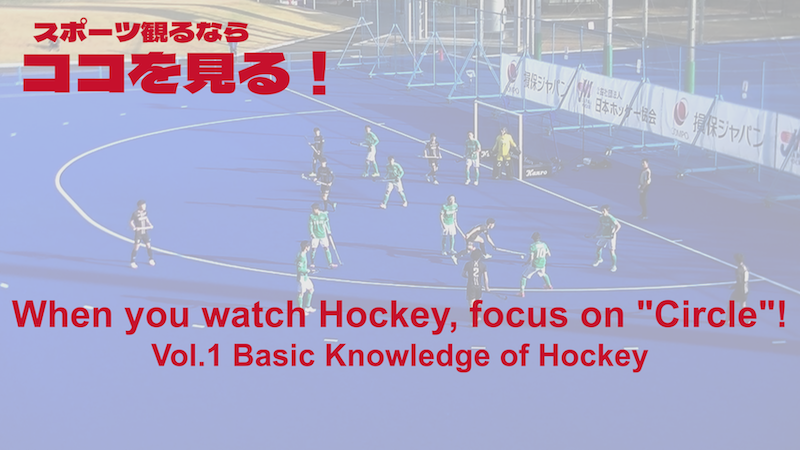
コメントを残す